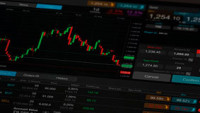 There was a more negative tone for European markets yesterday after the solid session from Wednesday, which saw the DAX trade at fresh record highs.
There was a more negative tone for European markets yesterday after the solid session from Wednesday, which saw the DAX trade at fresh record highs.
This was driven by weakness in Asia markets prompted by weak Chinese trade data, and the Moody’s’ downgrade to the credit outlook for China weighing on overall risk sentiment.
US markets shrugged off this negativity with a surge in the Nasdaq 100 pulling the rest of the market higher as optimism over AI helped to lift almost all boats, while a sharp slowdown in continuing jobless claims helped paint a picture of a resilient US labour market despite this week’s lacklustre ADP jobs report.
There is no question that jobs growth in the US is slowing, however anyone thinking that the jobs slowdown is anything other than a natural evolution to a tightening labour market, and not a precursor to a hard landing isn’t getting any encouragement for that latter view.
Last month’s October jobs report was the first one this year when the headline number came in below market expectations, though not by enough to raise concerns over the resilience of the US economy, and the labour market.
Unlike September, when US jobs surged by 297k, jobs growth slowed in October to 150k, while the unemployment rate ticked higher to 3.9%, in a sign that the US economy is now starting to slow in a manner that will please the US central bank.
Combined with a similarly weak ADP report the same week, where jobs growth slowed to 106k, and a softer ISM services survey yields have slipped back significantly from their October peaks, as well as being below the levels they were a month ago in a sign that the market thinks that rate hikes are done and has now moved on to when to expect rate cuts.
This week’s ISM and ADP numbers have done little to change that narrative and is already presenting a challenge to the US central bank and the FOMC.
This is the next challenge for the US central bank who will be keen to continue to push the higher for longer rates mantra.
We also saw that JOLTS job openings fell to 8.7m in October from 9.35m, while weekly jobless claims are still trending in the low 200k’s which means the Fed still has plenty of leeway to push back on current market pricing on rate cuts when they meet next week.
Expectations are for 183k jobs to be added in November; however, it should also be remembered that a lot of additional hiring takes place in the weeks leading up to Thanksgiving and the Christmas period which might see the numbers come in higher.
Whatever number we get it would be a big surprise to see any evidence of cracking in the US labour market this side of 2024, with labour force participation set to remain unchanged at 62.7%, and the unemployment rate at 3.9%
The USD/JPY continues to be a big mover after yesterday’s plunge with the yen surging after Bank of Japan governor Kazuo Ueda hinted that a policy pivot might be on the horizon as traders speculated that the time might be close when the BoJ moves to pull interest rates out of negative territory. This surge in the yen has translated into a sharp fall in the Nikkei 225 in another negative week for the Japanese benchmark. Its been a more positive week for other markets in Asia with the ASX200 and KOSPI finishing higher, with the Hang Seng also underperforming.
While the yen was a big gainer yesterday this possible shift in policy appears to have caught a lot of people off-guard with further yen strength possible on a move below 140.00. With the Bank of Japan so far behind the curve when it comes to raising rates it seems somewhat bizarre that we could see a situation where the Japanese central bank is starting to normalise policy at precisely the time the likes of the ECB, and the Federal Reserve have already hit peak terminal rate and are on the cusp of the start of a rate cut cycle next year.
Today’s German inflation numbers for November are expected to be confirmed at 2.3%, with a month on month decline of -0.7%.
EUR/USD – found a bit of a short-term base at 1.0750 edging back towards the 200-day SMA but needs to close back above the 1.0830 area to look at retesting the 1.0940 area. Support at the 1.0750 area and below that at 1.0670.
GBP/USD – edged below the 1.2570 area to 1.2544 before recovering but needs to get back above 1.2630 to retest the 1.2740 area. The main support on the downside at the 1.2460 area and 200-day SMA.
EUR/GBP – currently range trading between 0.8590 and the lows this week at 0.8550. While below the 0.8615/20 area the risk remains for a move towards the September lows at 0.8520, and potentially further towards the August lows at 0.8490.
USD/JPY – dropped like a stone yesterday sliding below the 146.20 area, dropping briefly below the 200-day SMA at 142.10 to 141.60 before recovering. We’ve seen another sharp drop and recovery off the 200-day SMA today. We need to see a daily close below the 200-day SMA to open a test of 140.00 and then on towards 135.00. Resistance back at 146.20.












